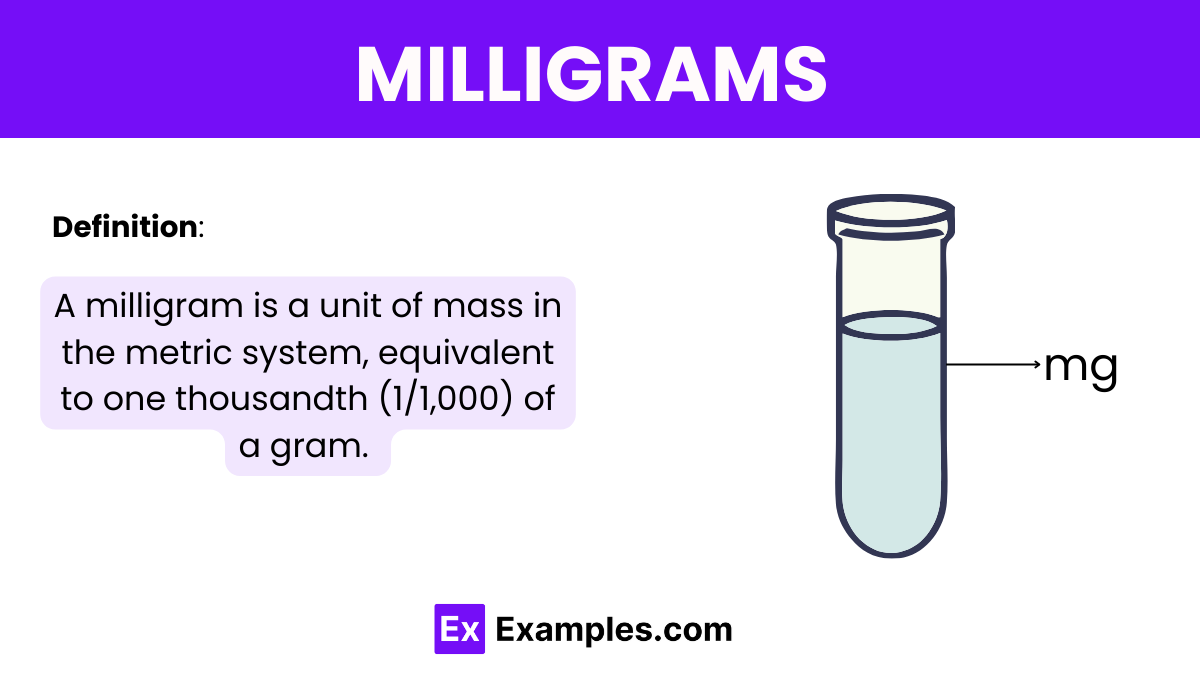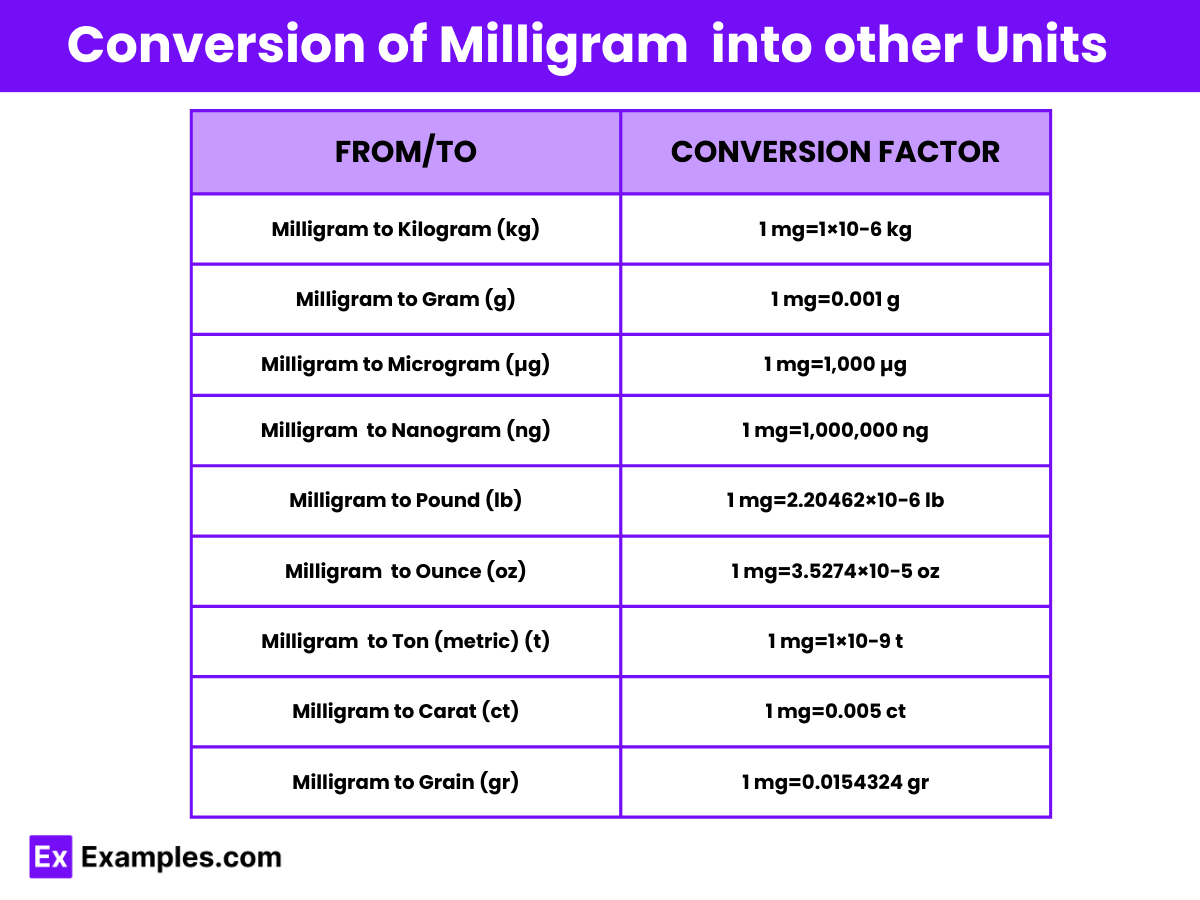How many milligrams are there in one gram?
10 milligrams
100 milligrams
500 milligrams
1000 milligrams


A milligram is a unit of mass in the metric system, equivalent to one thousandth (1/1,000) of a gram. It’s a standard unit used in various contexts, particularly in science, medicine, and nutrition, to measure very small weights. The milligram is widely used for quantifying the amount of active ingredients in medications, the nutritional content in foods, and the concentration of substances in scientific samples.
The formula to express a milligram in relation to a gram is:
| Factor | Prefix | Symbol | Value in Milligrams |
|---|---|---|---|
| 10³ | kilogram | kg | 1,000,000 mg |
| 10² | hectogram | hg | 100,000 mg |
| 10¹ | decagram | dag | 10,000 mg |
| 10⁰ | gram | g | 1,000 mg |
| 10−1 | decigram | dg | 100 mg |
| 10−2 | centigram | cg | 10 mg |
| 10−3 | milligram | mg | 1 mg |
| 10−6 | microgram | µg | 0.001 mg |
| 10−9 | nanogram | ng | 0.000001 mg |
| 10−12 | picogram | pg | 0.000000001 mg |
| 10−15 | femtogram | fg | 0.000000000001 mg |
| 10−18 | attogram | ag | 0.000000000000001 mg |

| Unit | Symbol | Conversion from Milligrams |
|---|---|---|
| Kilogram | kg | 1 mg = 1×10−⁶kg |
| Gram | g | 1 mg = 0.001 g |
| Microgram | µg | 1 mg = 1,000 µg |
| Nanogram | ng | 1 mg = 1,000,000 ng |
| Pound | lb | 1 mg = 2.20462×10−⁶ lb |
| Ounce | oz | 1 mg = 3.5274×10−⁵ oz |
| Ton (metric) | t | 1 mg = 1×10−⁹ t |
| Carat | ct | 1 mg = 0.005 ct |
| Grain | gr | 1 mg = 0.0154324 gr |
A kilogram is a unit of mass that is equal to 1,000 grams, or 1,000,000 milligrams. This conversion is useful in situations where mass is required in a larger scale, such as in cooking or grocery measurements.
A gram is a unit of mass equal to 1,000 milligrams. This is a common conversion in scientific and laboratory settings where precise measurements are crucial.
A microgram is one-thousandth of a milligram. This unit is often used in medical dosages and scientific research where extremely small mass measurements are needed.
The pound is a larger unit of mass used primarily in the United States. This conversion can be handy when translating medical prescriptions or food recipes from metric to imperial units.
An ounce is a unit of weight used primarily in the U.S. and the U.K. It’s useful for very precise measurements in cooking or in industries dealing with small quantities of material.
A metric ton is equivalent to 1,000,000 grams or 1,000 kilograms. This conversion is rarely used directly from milligrams due to the vast difference in scale but can be important in industrial or large-scale environmental calculations.
Carats are used primarily to measure the weight of gemstones and pearls. One carat is equivalent to 200 milligrams.
The grain is a unit of mass used historically in the troy systems of mass and now commonly for measuring bullets and gunpowder. One grain is equal to roughly 64.79891 milligrams.
A nanogram is one-billionth of a gram or one-millionth of a milligram. This unit is incredibly small and is frequently used in chemistry, biology, and medicine, particularly in drug development, genetic research, and biochemistry where measuring tiny amounts is crucial.

In physics, the milligram, a unit of mass in the metric system, plays a critical role in various applications and experiments. Here are some key uses of milligrams in the field of physics:
Material Science:
Milligrams are often used to measure the masses of small samples of materials. This precision is crucial for determining the density and other physical properties of materials like nanomaterials, thin films, and polymers.
Pharmaceutical Physics:
In pharmaceutical physics, milligrams are used to measure the mass of active ingredients in drugs. Understanding the mass is essential for ensuring the correct dosage and effectiveness of medications.
Chemical Reactions:
In experimental physics involving chemistry, milligrams are used to measure small amounts of reagents for reactions. Accurate measurement influences the stoichiometry and outcomes of the reactions, which is crucial for research and development.
Calibration and Standards:
Milligrams are used in the calibration of instruments that measure weight and balance. Precision in calibration standards is crucial for experiments requiring high accuracy in mass measurements.
Gravitational Experiments:
In experiments that explore gravitational effects on small objects or over short distances, milligrams provide a way to measure tiny forces accurately. This can be important in research areas like microgravity and fundamental physics.
Environmental Physics:
Milligrams are used to quantify very small amounts of pollutants or trace elements in environmental samples. This helps in studying their effects and concentrations in ecosystems, crucial for environmental monitoring and compliance.
No, a milligram is not a unit of volume; it is a unit of mass. In the metric system, milligrams are used to measure the mass of very small objects or substances.
Milligrams (mg) and milliliters (mL) are units for measuring different properties, so they cannot be directly compared in terms of size. Milligrams measure mass, whereas milliliters measure volume.
Text prompt
Add Tone
10 Examples of Public speaking
20 Examples of Gas lighting
How many milligrams are there in one gram?
10 milligrams
100 milligrams
500 milligrams
1000 milligrams
If a tablet contains 250 milligrams of active ingredient, how many grams is this?
0.25 grams
2.5 grams
25 grams
0.025 grams
Convert 5 grams to milligrams.
500 milligrams
5000 milligrams
50 milligrams
0.5 milligrams
How many grams are in 1500 milligrams?
1.5 grams
0.15 grams
15 grams
0.015 grams
What is the mass of 0.75 grams in milligrams?
750 milligrams
75 milligrams
7.5 milligrams
0.075 milligrams
If a solution has a concentration of 20 milligrams per milliliter, how many milligrams are in 3 milliliters?
60 milligrams
6 milligrams
600 milligrams
0.6 milligrams
How many milligrams are there in 2.5 grams?
2500 milligrams
250 milligrams
25 milligrams
0.25 milligrams
Convert 0.03 grams to milligrams.
300 milligrams
30 milligrams
3 milligrams
0.3 milligrams
What is the mass of 200 milligrams in grams?
0.2 grams
2 grams
20 grams
0.02 grams
If a capsule contains 500 milligrams of medication, how many grams is this?
0.05 grams
5 grams
0.5 grams
50 grams
Before you leave, take our quick quiz to enhance your learning!

